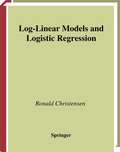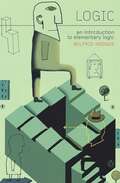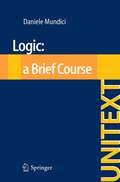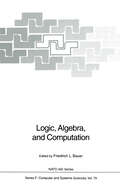- Table View
- List View
Location Theory: A Unified Approach
by Stefan Nickel Justo PuertoAlthough modern location theory is now more than 90 years old, the focus of researchers in this area has been mainly problem oriented. However, a common theory, which keeps the essential characteristics of classical location models, is still missing. This monograph addresses this issue. A flexible location problem called the Ordered Median Problem (OMP) is introduced. For all three main subareas of location theory (continuous, network and discrete location) structural properties of the OMP are presented and solution approaches provided. Numerous illustrations and examples help the reader to become familiar with this new location model. By using OMP classical results of location theory can be reproved in a more general and sometimes even simpler way. Algorithms enable the reader to solve very flexible location models with a single implementation. In addition, the code of some algorithms is available for download.
Loci - Circle and Perpendicular Bisector Examples (tactile)
by RnibThis image shows two examples of loci. Diagram 1 at the top of the page shows a circle with the radiu labelled 4cm. Diagram 2 below shows and example of perpendicular bisector loci.
Locus of a point - Circle (tactile)
by RnibThis diagram show a circle. The radius is labelled 2 cm and the centre is labelled D.
Loeb Measures in Practice: EMS Lectures 1997 (Lecture Notes in Mathematics #1751)
by Nigel J. CutlandThis expanded version of the 1997 European Mathematical Society Lectures given by the author in Helsinki, begins with a self-contained introduction to nonstandard analysis (NSA) and the construction of Loeb Measures, which are rich measures discovered in 1975 by Peter Loeb, using techniques from NSA. Subsequent chapters sketch a range of recent applications of Loeb measures due to the author and his collaborators, in such diverse fields as (stochastic) fluid mechanics, stochastic calculus of variations ("Malliavin" calculus) and the mathematical finance theory. The exposition is designed for a general audience, and no previous knowledge of either NSA or the various fields of applications is assumed.
Loewner's Theorem on Monotone Matrix Functions (Grundlehren der mathematischen Wissenschaften #354)
by Barry SimonThis book provides an in depth discussion of Loewner’s theorem on the characterization of matrix monotone functions. The author refers to the book as a ‘love poem,’ one that highlights a unique mix of algebra and analysis and touches on numerous methods and results. The book details many different topics from analysis, operator theory and algebra, such as divided differences, convexity, positive definiteness, integral representations of function classes, Pick interpolation, rational approximation, orthogonal polynomials, continued fractions, and more. Most applications of Loewner’s theorem involve the easy half of the theorem. A great number of interesting techniques in analysis are the bases for a proof of the hard half. Centered on one theorem, eleven proofs are discussed, both for the study of their own approach to the proof and as a starting point for discussing a variety of tools in analysis. Historical background and inclusion of pictures of some of the main figures who have developed the subject, adds another depth of perspective.The presentation is suitable for detailed study, for quick review or reference to the various methods that are presented. The book is also suitable for independent study. The volume will be of interest to research mathematicians, physicists, and graduate students working in matrix theory and approximation, as well as to analysts and mathematical physicists.
Loewy Decomposition of Linear Differential Equations (Texts & Monographs in Symbolic Computation)
by Fritz SchwarzThe central subject of the book is the generalization of Loewy's decomposition - originally introduced by him for linear ordinary differential equations - to linear partial differential equations. Equations for a single function in two independent variables of order two or three are comprehensively discussed. A complete list of possible solution types is given. Various ad hoc results available in the literature are obtained algorithmically. The border of decidability for generating a Loewy decomposition are explicitly stated. The methods applied may be generalized in an obvious way to equations of higher order, in more variables or systems of such equations.
Log-Gases and Random Matrices (LMS-34)
by Peter J. ForresterRandom matrix theory, both as an application and as a theory, has evolved rapidly over the past fifteen years. Log-Gases and Random Matrices gives a comprehensive account of these developments, emphasizing log-gases as a physical picture and heuristic, as well as covering topics such as beta ensembles and Jack polynomials. Peter Forrester presents an encyclopedic development of log-gases and random matrices viewed as examples of integrable or exactly solvable systems. Forrester develops not only the application and theory of Gaussian and circular ensembles of classical random matrix theory, but also of the Laguerre and Jacobi ensembles, and their beta extensions. Prominence is given to the computation of a multitude of Jacobians; determinantal point processes and orthogonal polynomials of one variable; the Selberg integral, Jack polynomials, and generalized hypergeometric functions; Painlevé transcendents; macroscopic electrostatistics and asymptotic formulas; nonintersecting paths and models in statistical mechanics; and applications of random matrix theory. This is the first textbook development of both nonsymmetric and symmetric Jack polynomial theory, as well as the connection between Selberg integral theory and beta ensembles. The author provides hundreds of guided exercises and linked topics, making Log-Gases and Random Matrices an indispensable reference work, as well as a learning resource for all students and researchers in the field.
Log-Linear Models (Springer Texts in Statistics)
by Ronald ChristensenThis book examines log-linear models for contingency tables. Logistic re gression and logistic discrimination are treated as special cases and gener alized linear models (in the GLIM sense) are also discussed. The book is designed to fill a niche between basic introductory books such as Fienberg (1980) and Everitt (1977) and advanced books such as Bishop, Fienberg, and Holland (1975), Haberman (1974), and Santner and Duffy (1989). lt is primarily directed at advanced Masters degree students in Statistics but it can be used at both higher and lower levels. The primary theme of the book is using previous knowledge of analysis of variance and regression to motivate and explicate the use of log-linear models. Of course, both the analogies and the distinctions between the different methods must be kept in mind. The book is written at several levels. A basic introductory course would take material from Chapters I, II (deemphasizing Section II. 4), III, Sec tions IV. 1 through IV. 5 (eliminating the material on graphical models), Section IV. lü, Chapter VII, and Chapter IX. The advanced modeling ma terial at the end of Sections VII. 1, VII. 2, and possibly the material in Section IX. 2 should be deleted in a basic introductory course. For Mas ters degree students in Statistics, all the material in Chapters I through V, VII, IX, and X should be accessible. For an applied Ph. D.
Log-Linear Models and Logistic Regression (Springer Texts in Statistics)
by Ronald ChristensenThe primary focus here is on log-linear models for contingency tables, but in this second edition, greater emphasis has been placed on logistic regression. The book explores topics such as logistic discrimination and generalised linear models, and builds upon the relationships between these basic models for continuous data and the analogous log-linear and logistic regression models for discrete data. It also carefully examines the differences in model interpretations and evaluations that occur due to the discrete nature of the data. Sample commands are given for analyses in SAS, BMFP, and GLIM, while numerous data sets from fields as diverse as engineering, education, sociology, and medicine are used to illustrate procedures and provide exercises. Throughoutthe book, the treatment is designed for students with prior knowledge of analysis of variance and regression.
Logarithmic Potentials with External Fields (Grundlehren der mathematischen Wissenschaften #316)
by Edward B. Saff Vilmos TotikIn recent years approximation theory and the theory of orthogonal polynomials have witnessed a dramatic increase in the number of solutions of difficult and previously untouchable problems. This is due to the interaction of approximation theoretical techniques with classical potential theory (more precisely, the theory of logarithmic potentials, which is directly related to polynomials and to problems in the plane or on the real line). Most of the applications are based on an exten sion of classical logarithmic potential theory to the case when there is a weight (external field) present. The list of recent developments is quite impressive and includes: creation of the theory of non-classical orthogonal polynomials with re spect to exponential weights; the theory of orthogonal polynomials with respect to general measures with compact support; the theory of incomplete polynomials and their widespread generalizations, and the theory of multipoint Pade approximation. The new approach has produced long sought solutions for many problems; most notably, the Freud problems on the asymptotics of orthogonal polynomials with a respect to weights of the form exp(-Ixl ); the "l/9-th" conjecture on rational approximation of exp(x); and the problem of the exact asymptotic constant in the rational approximation of Ixl. One aim of the present book is to provide a self-contained introduction to the aforementioned "weighted" potential theory as well as to its numerous applications. As a side-product we shall also fully develop the classical theory of logarithmic potentials.
Logarithms and Antilogarithms: An Algebraic Analysis Approach (Mathematics and Its Applications #437)
by D. Przeworska-RolewiczLogic: From Foundations To Applications - European Logic Colloquium (A\pelican Original Ser. #No. 3)
by Wilfrid HodgesIf a man supports Arsenal one day and Spurs the next then he is fickle but not necessarily illogical. From this starting point, and assuming no previous knowledge of logic, Wilfrid Hodges takes the reader through the whole gamut of logical expressions in a simple and lively way. Readers who are more mathematically adventurous will find optional sections introducing rather more challenging material. 'A lively and stimulating book' Philosophy
Logic: a Brief Course (UNITEXT)
by Daniele MundiciThis short book, geared towards undergraduate students of computer science and mathematics, is specifically designed for a first course in mathematical logic. A proof of Gödel's completeness theorem and its main consequences is given using Robinson's completeness theorem and Gödel's compactness theorem for propositional logic. The reader will familiarize himself with many basic ideas and artifacts of mathematical logic: a non-ambiguous syntax, logical equivalence and consequence relation, the Davis-Putnam procedure, Tarski semantics, Herbrand models, the axioms of identity, Skolem normal forms, nonstandard models and, interestingly enough, proofs and refutations viewed as graphic objects. The mathematical prerequisites are minimal: the book is accessible to anybody having some familiarity with proofs by induction. Many exercises on the relationship between natural language and formal proofs make the book also interesting to a wide range of students of philosophy and linguistics.
Logic, Algebra, and Computation: International Summer School (NATO ASI Subseries F: #79)
by F. L. Bauer W. Brauer G. Huet J. A. Robinson H. SchwichtenbergThe Marktoberdorf Summer Schools on Informatics were started in 1970, with the intention to convene every second or third year a group of top researchers in computing, devoted to preach their most recent results to an elite of advanced students - young and most promising people - and prepared to stand their questions, criticism and suggestions. The themes of these Advanced Study In stitutes under the sponsorship of the NATO Scientific Affairs Division varied slightly over the years, oscillating more or less around Programming Methodo logy, as the following list shows: 1970 Data Structures and Computer Systems 1971 Program Structures and Fundamental Concepts of Programming 1973 Structured Programming and Programmed Structures 1975 Language Hierarchies and Interfaces 1978 Program Construction 1981 Theoretical Foundations of Programming Methodology 1984 Control Flow and Data Flow: Concepts of Distributed Programming 1986 Logic of Programming and Calculi of Discrete Design 1988 Constructive Methods in Computing Science 1989 Logic, Algebra, and Computation Logic, Algebra, and Computation is the theme of the summer school to which this volume is devoted. It is the tenth in succession, but it is also the first in a new series (the "blue" series) that is intended to alternate in future with the traditional (the "red" series) arrangement; in fact the tenth summer school in the "red" series with the title "Programming and Mathematical Method" , held in 1990, was the subject of celebrating both its serial number and the twenty years of Marktoberdorf Summer Schools altogether.
Logic and Algebra (Lecture Notes In Pure And Applied Mathematics Ser.)
by Aldo Ursini and Paolo Aglianò""Attempts to unite the fields of mathematical logic and general algebra. Presents a collection of refereed papers inspired by the International Conference on Logic and Algebra held in Siena, Italy, in honor of the late Italian mathematician Roberto Magari, a leading force in the blossoming of research in mathematical logic in Italy since the 1960s.
Logic and Algebra (Lecture Notes In Pure And Applied Mathematics Ser.)
by Aldo Ursini""Attempts to unite the fields of mathematical logic and general algebra. Presents a collection of refereed papers inspired by the International Conference on Logic and Algebra held in Siena, Italy, in honor of the late Italian mathematician Roberto Magari, a leading force in the blossoming of research in mathematical logic in Italy since the 1960s.
Logic and Algebra of Specification (NATO ASI Subseries F: #94)
by Friedrich L. Bauer Wilfried Brauer Helmut SchwichtenbergFor some years, specification of software and hardware systems has been influenced not only by algebraic methods but also by new developments in logic. These new developments in logic are partly based on the use of algorithmic techniques in deduction and proving methods, but are alsodue to new theoretical advances, to a great extent stimulated by computer science, which have led to new types of logic and new logical calculi. The new techniques, methods and tools from logic, combined with algebra-based ones, offer very powerful and useful tools for the computer scientist, which may soon become practical for commercial use, where, in particular, more powerful specification tools are needed for concurrent and distributed systems. This volume contains papers based on lectures by leading researchers which were originally given at an international summer school held in Marktoberdorf in 1991. The papers aim to give a foundation for combining logic and algebra for the purposes of specification under the aspects of automated deduction, proving techniques, concurrency and logic, abstract data types and operational semantics, and constructive methods.
Logic and Argumentation: 4th International Conference, CLAR 2021, Hangzhou, China, October 20–22, 2021, Proceedings (Lecture Notes in Computer Science #13040)
by Christoph Benzmüller Yì N. Wáng Pietro BaroniThis book constitutes the refereed proceedings of the 4th International Conference on Logic and Argumentation, CLAR 2021, held in Hangzhou, China, in October 2021. The 20 full and 10 short papers presented together with 5 invited papers were carefully reviewed and selected from 58 submissions. The topics of accepted papers cover the focus of the CLAR series, including formal models of argumentation, a variety of logic formalisms, nonmonotonic reasoning, dispute and dialogue systems, formal treatment of preference and support, and well as applications in areas like vaccine information and processing of legal texts.
Logic and Argumentation: 5th International Conference, CLAR 2023, Hangzhou, China, September 10-12, 2023, Proceedings (Lecture Notes in Computer Science #14156)
by Andreas Herzig Jieting Luo Pere PardoThis book constitutes the refereed proceedings of the 5th International Conference on Logic and Argumentation, CLAR 2023, held in Hangzhou, China, during September 10-12, 2023. The 11 full papers, one short paper and one invited paper presented in this book were carefully reviewed and selected from 20 submissions. The papers focus on topics such as: logic and automated deduction; abstract and structured argumentation; dialogues, games and practical reasoning; and quantitative argumentation.
Logic and Complexity (Discrete Mathematics and Theoretical Computer Science)
by Richard Lassaigne Michel de RougemontLogic and Complexity looks at basic logic as it is used in Computer Science, and provides students with a logical approach to Complexity theory. With plenty of exercises, this book presents classical notions of mathematical logic, such as decidability, completeness and incompleteness, as well as new ideas brought by complexity theory such as NP-completeness, randomness and approximations, providing a better understanding for efficient algorithmic solutions to problems. Divided into three parts, it covers: - Model Theory and Recursive Functions - introducing the basic model theory of propositional, 1st order, inductive definitions and 2nd order logic. Recursive functions, Turing computability and decidability are also examined. - Descriptive Complexity - looking at the relationship between definitions of problems, queries, properties of programs and their computational complexity. - Approximation - explaining how some optimization problems and counting problems can be approximated according to their logical form. Logic is important in Computer Science, particularly for verification problems and database query languages such as SQL. Students and researchers in this field will find this book of great interest.
Logic and Computer Science: Lectures given at the 1st Session of the Centro Internazionale Matematico Estivo (C.I.M.E.) held at Montecatini Terme, Italy, June 20-28, 1988 (Lecture Notes in Mathematics #1429)
by Steven Homer Anil Nerode Richard A. Platek Gerald E. Sacks Andre ScedrovThe courses given at the 1st C.I.M.E. Summer School of 1988 dealt with the main areas on the borderline between applied logic and theoretical computer science. These courses are recorded here in five expository papers: S. Homer: The Isomorphism Conjecture and its Generalization.- A. Nerode: Some Lectures on Intuitionistic Logic.- R.A. Platek: Making Computers Safe for the World. An Introduction to Proofs of Programs. Part I. - G.E. Sacks: Prolog Programming.- A. Scedrov: A Guide to Polymorphic Types.
Logic and Discrete Mathematics: A Concise Introduction
by Willem Conradie Valentin GorankoA concise yet rigorous introduction to logic and discrete mathematics. This book features a unique combination of comprehensive coverage of logic with a solid exposition of the most important fields of discrete mathematics, presenting material that has been tested and refined by the authors in university courses taught over more than a decade. The chapters on logic - propositional and first-order - provide a robust toolkit for logical reasoning, emphasizing the conceptual understanding of the language and the semantics of classical logic as well as practical applications through the easy to understand and use deductive systems of Semantic Tableaux and Resolution. The chapters on set theory, number theory, combinatorics and graph theory combine the necessary minimum of theory with numerous examples and selected applications. Written in a clear and reader-friendly style, each section ends with an extensive set of exercises, most of them provided with complete solutions which are available in the accompanying solutions manual. Key Features: Suitable for a variety of courses for students in both Mathematics and Computer Science. Extensive, in-depth coverage of classical logic, combined with a solid exposition of a selection of the most important fields of discrete mathematics Concise, clear and uncluttered presentation with numerous examples. Covers some applications including cryptographic systems, discrete probability and network algorithms. Logic and Discrete Mathematics: A Concise Introduction is aimed mainly at undergraduate courses for students in mathematics and computer science, but the book will also be a valuable resource for graduate modules and for self-study.
Logic and Discrete Mathematics: A Concise Introduction
by Willem Conradie Valentin GorankoA concise yet rigorous introduction to logic and discrete mathematics. This book features a unique combination of comprehensive coverage of logic with a solid exposition of the most important fields of discrete mathematics, presenting material that has been tested and refined by the authors in university courses taught over more than a decade. The chapters on logic - propositional and first-order - provide a robust toolkit for logical reasoning, emphasizing the conceptual understanding of the language and the semantics of classical logic as well as practical applications through the easy to understand and use deductive systems of Semantic Tableaux and Resolution. The chapters on set theory, number theory, combinatorics and graph theory combine the necessary minimum of theory with numerous examples and selected applications. Written in a clear and reader-friendly style, each section ends with an extensive set of exercises, most of them provided with complete solutions which are available in the accompanying solutions manual. Key Features: Suitable for a variety of courses for students in both Mathematics and Computer Science. Extensive, in-depth coverage of classical logic, combined with a solid exposition of a selection of the most important fields of discrete mathematics Concise, clear and uncluttered presentation with numerous examples. Covers some applications including cryptographic systems, discrete probability and network algorithms. Logic and Discrete Mathematics: A Concise Introduction is aimed mainly at undergraduate courses for students in mathematics and computer science, but the book will also be a valuable resource for graduate modules and for self-study.
Logic and Discrete Mathematics: A Concise Introduction, Solutions Manual
by Willem Conradie Valentin Goranko Claudette RobinsonSolutions manual to accompany Logic and Discrete Mathematics: A Concise Introduction This book features a unique combination of comprehensive coverage of logic with a solid exposition of the most important fields of discrete mathematics, presenting material that has been tested and refined by the authors in university courses taught over more than a decade. Written in a clear and reader-friendly style, each section ends with an extensive set of exercises, most of them provided with complete solutions which are available in this accompanying solutions manual.
Logic and Discrete Mathematics: A Concise Introduction, Solutions Manual
by Willem Conradie Valentin Goranko Claudette RobinsonSolutions manual to accompany Logic and Discrete Mathematics: A Concise Introduction This book features a unique combination of comprehensive coverage of logic with a solid exposition of the most important fields of discrete mathematics, presenting material that has been tested and refined by the authors in university courses taught over more than a decade. Written in a clear and reader-friendly style, each section ends with an extensive set of exercises, most of them provided with complete solutions which are available in this accompanying solutions manual.




















